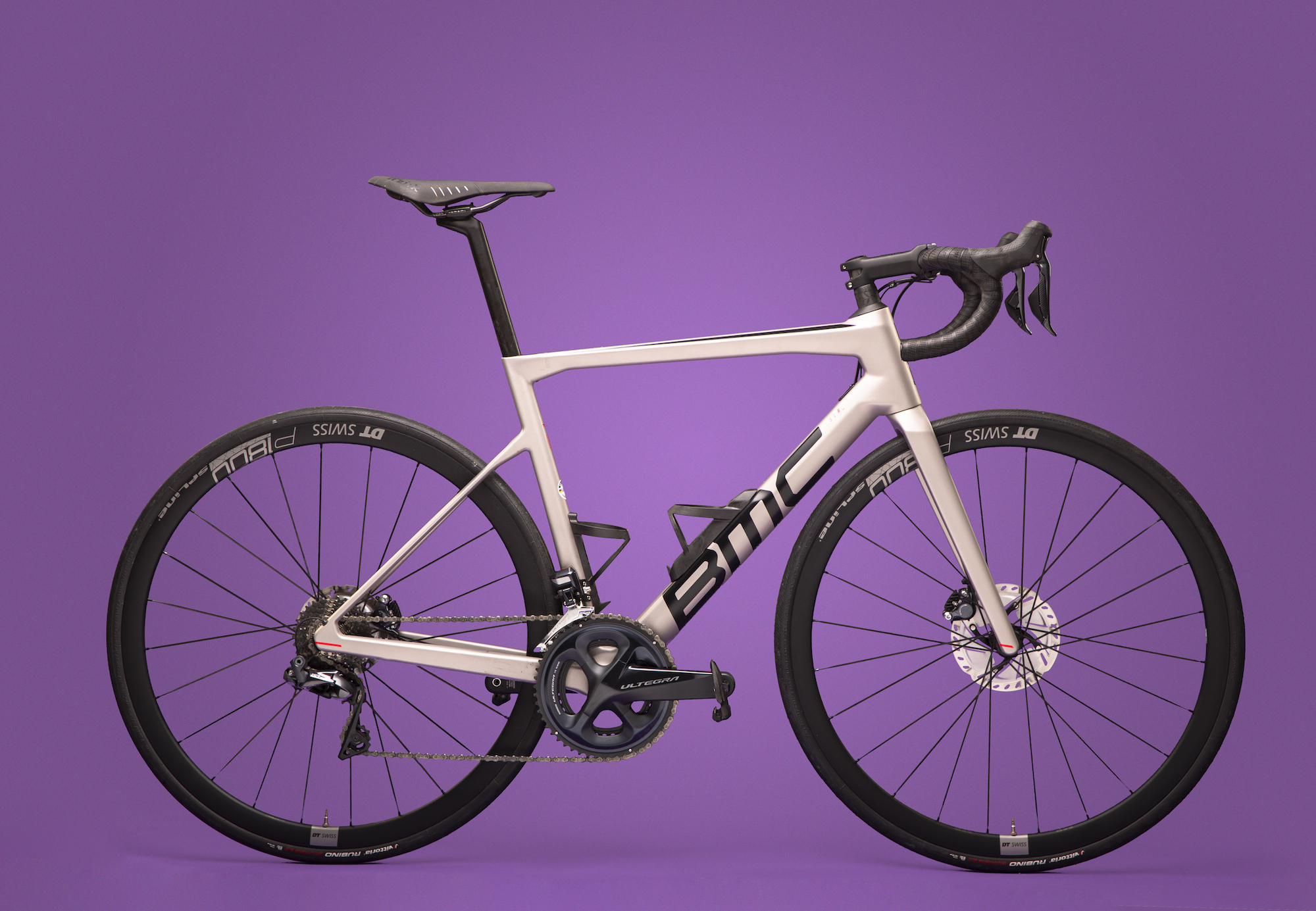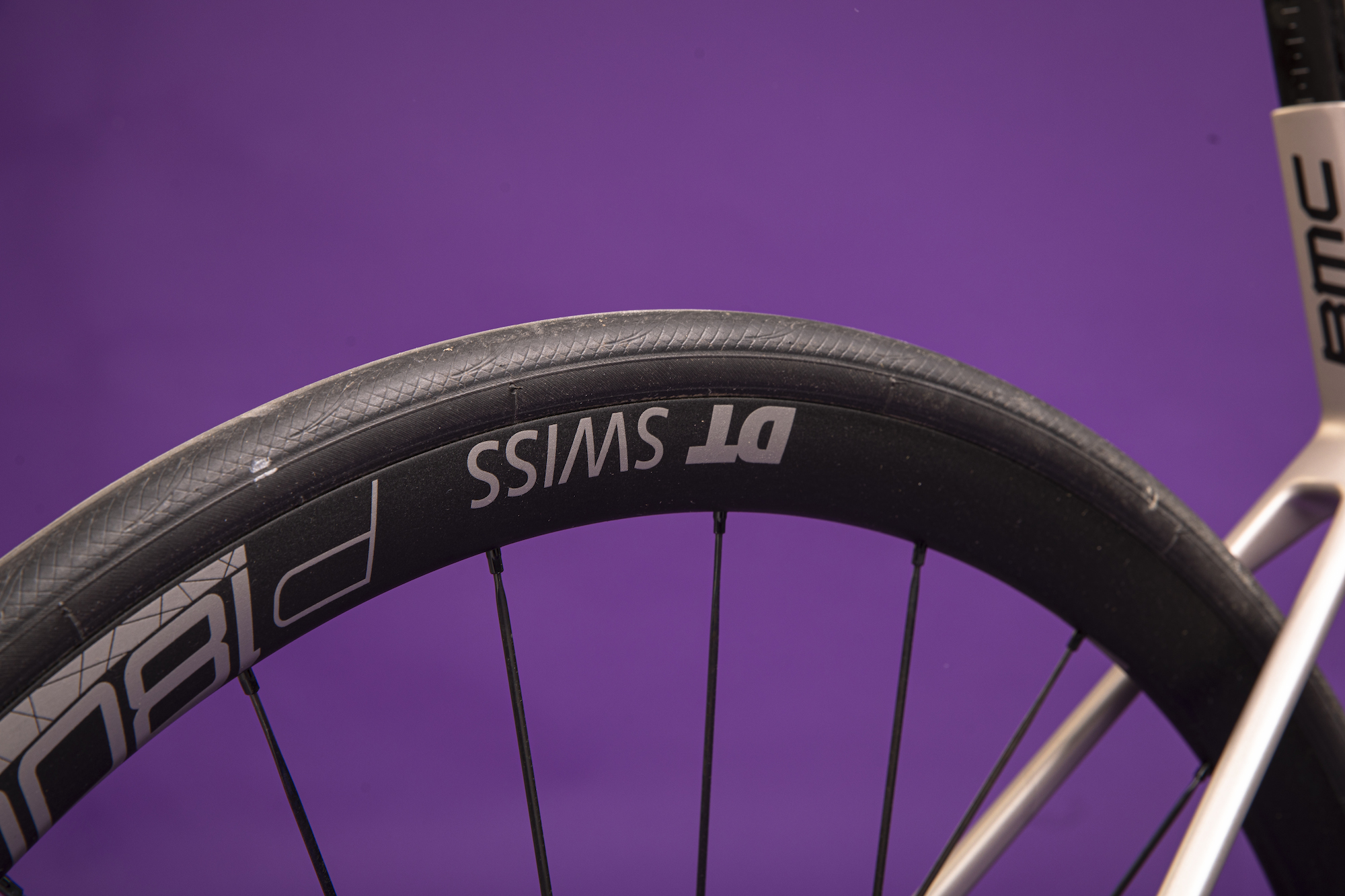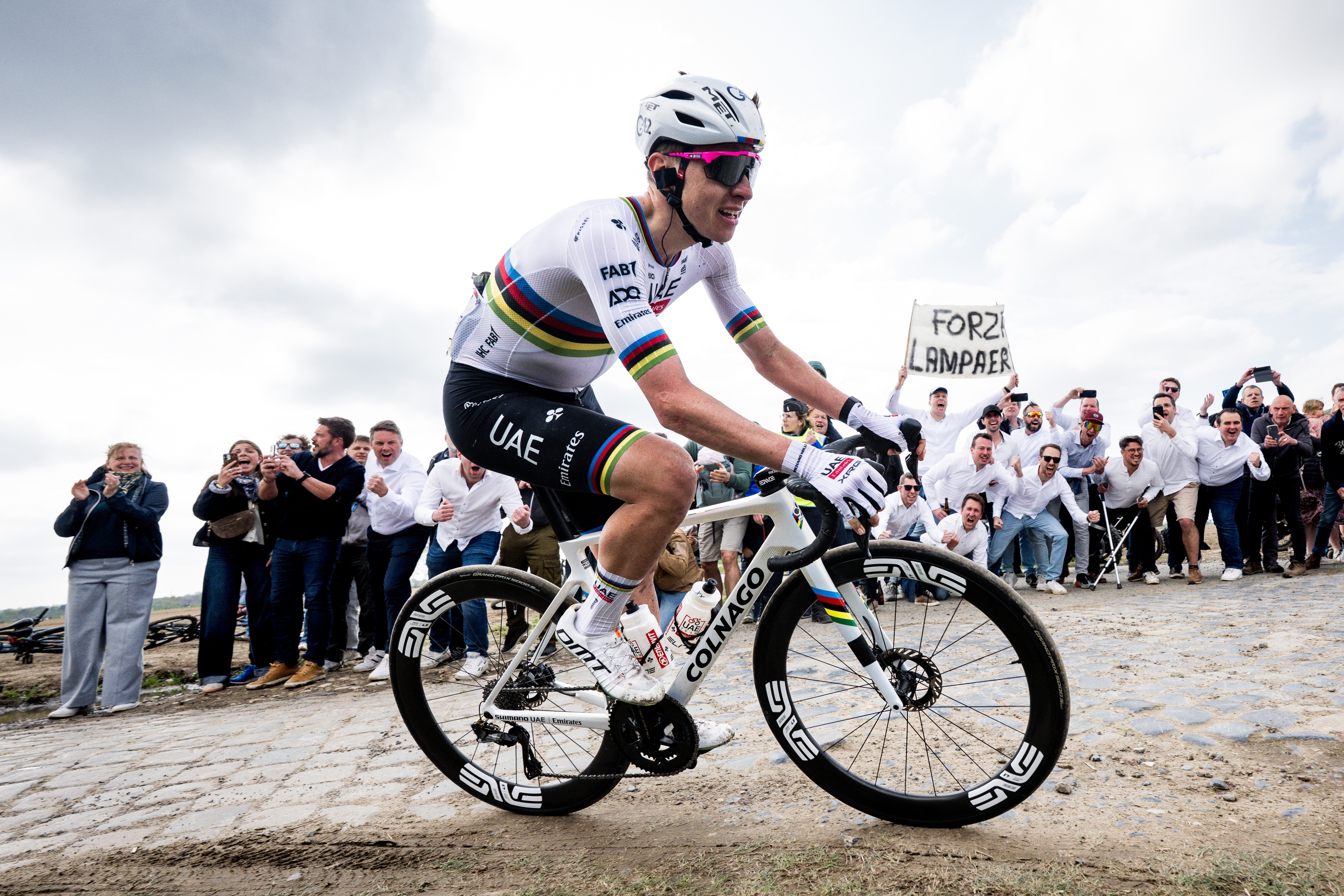BMC Teammachine SLR TWO review
The lower-priced, consumer version of BMC's WorldTour race bike is a fast, exciting ride – but is more adversely affected by budget components than some rival manufacturers' frames

The BMC Teammachine SLR TWO is a fast, racy bike with aggressive geometry and sharp but well balanced handling – but both its ride quality and its weight suffer due to the speccing of budget aluminium wheels.
-
+
Stiff
-
+
Responsive
-
+
Distinctive looks
-
-
Budget aluminium wheels
-
-
Heavy
You can trust Cycling Weekly.

We tested the BMC Teammachine SLR TWO as part of a four bike shoot-out which also included the Specialized Tarmac SL7 Expert, Scott Addict 15 and Giant TCR Advanced Pro 0. Each bike was tested with its stock tyre, and a control tyre (Schwalbe Pro One TLE, 25mm), using the same test loop which covered 32 miles and included ascents and descents of Leith Hill and Box Hill in Surrey.
The full set of reviews and final conclusions will be published in Cycling Weekly magazine, out on Thursday April 29.
It’s now in its 11th year and it’s got all the big wins under its belt: the Tour de France with Cadel Evans in 2011, the World Championship with Philippe Gilbert in 2012, Olympic gold with Greg Van Avermaet in 2016 – and this fourth-generation BMC Teammachine is the bike of both Ag2r and Qhubeka in the WorldTour this year.
The pro team bike is the BMC Teammachine SLR01, which in its top spec with SRAM Red eTap AXS costs just short of £10,000 and weighs a claimed 6.57kg.
With a little reconfiguring of suffixes, not to mention the use of the Swiss brand’s second-tier carbon and a lower-priced, Ultegra Di2-based spec, the BMC Teammachine SLR TWO costs less than half that, and weighs almost a kilo-and-a-half more.
BMC Teammachine SLR TWO: frame and fork
While bike brands like to supply claimed percentage improvements – weight, aerodynamics and compliance (or stiffness) are the big three – of the new flagship model over the previous one, there’s not so much information available about the lower-priced models. However, since the tube shapes are exactly the same it’s safe to say that the Teammachine SLR TWO frame shares the SLR01's aerodynamic advantage of six per cent over the older Teammachine. It definitely says that BMC – like the other big brands – is bringing aerodynamics to a formerly purely lightweight bike. It has a dedicated aero bike in the Timemachine Road.

It has to be said that the BMC Teammachine’s distinctly angular frame doesn’t look the most aerodynamic, especially compared to the smoother, curvier Specialized Tarmac, Scott Addict and newly smoothed Giant TCR, which we tested at the same time, but there are some neat little watt-saving details such as the Stealth Dropouts, in which the captive end of the dropout is closed off, the use of proprietary bottle cages (Aerocore) and a redesigned fork.
The flagship model of the BMC Teammachine had its stiffness dial turned up in the 2021 iteration, by a reported 20 per cent - and the TWO version shares the same shapes, albeit with a slightly lower grade carbon.
Like the majority of carbon frames – with the exception of the Specialized Tarmac SL7 on this test, which has reverted to the arguably more reliable threaded bottom bracket system – it uses the PF86 pressfit standard, which ran creak-free for the test period.
The latest Teammachine is disc brake only – like the Specialized Tarmac SL7 and the Scott Addict RC, with the Giant TCR Advanced the only bike in our test still available with rim brakes.
The advantage of discs is of course that clearance can generally be improved, and there’s enough here for 30mm tyres – although the Teammachine TWO comes with 25 Vittoria Rubinos as stock.

As for the frame's cable routing, there’s nothing fancy going on: the SLR TWO gets a surprisingly standard bar and stem, with cables running into the left hand side of the head tube, as with the Giant.
The junction box is sited on the down tube rather than in the bar end, which is neither an advantage nor a disadvantage, but it’s nice to have it where you can see it easily, especially if you want to do a battery check or change shift modes, for example.
Geometry is steep at the rear end compared to the other bikes on test – it gets an extra half degree at 73.5°C – but is paired with a relatively shallow head tube angle (72.3°). Stack and reach also where you'd expect them to be across the six sizes.
Components
As with all four bikes in our test, the BMC Teammachine SLR TWO has a full Shimano Ultegra Di2 groupset which, as ever, gets a big thumbs-up from us. It comes with 52/36 and 11-30 like the other three bikes.
As I’ve mentioned, the bar and stem are standard items, both BMC in-house aluminium components that do the job perfectly well.
The D-shaped seatpost is specific to the frame and uses BMC’s own clamp system rather than a wedge. It has 15mm of setback and this, paired with the relatively steep seat tube angle, places the rider in an aggressive position over the BB.

BMC has specced fairly low end, heavyish (1,750g), narrowish (internal rim width 18mm) DT Swiss P 1800 Spline aluminium wheels with a 32mm rim depth. For bikes at this price point there’s a decision to be made regarding the wheels: save some money and spec budget training wheels assuming the customer has their own race wheels – which is also what Specialized does with the Tarmac SL7 Expert – or do some careful budgeting to factor in decent wheels – as Scott and Giant have done. More about this in the ‘Ride’ section below, but these wheels are arguably are not ideal for showcasing the BMC’s ride quality, for me tipping it over from firm into harsh.
The Vittoria Rubino 25mm clinchers are also low end compared to the overall price of the BMC – they are all-rounder training tyres that lack a degree of suppleness and refinement.
But this section ends positively: the Fizik Antares R7 saddle is popular and suits a lot of bums, including mine.
Ride
I was literally shaken by the BMC’s ride quality the first time I headed out on it. This first ride was on some unfamiliar roads that I hadn’t ridden on since before the first lockdown and I assumed the surface might have deteriorated or I had simply forgotten what they were like.
I also found my average speed wasn’t what I was expecting compared to historical rides – and ageing or lack of fitness weren’t to blame, honest.
Suspicions were confirmed when I rode the test circuit I was using for the other three bikes: there was a lot of vibration coming up from the road, even with the tyres at 80psi.
However, what I did notice was that the BMC handled really well when leant over in corners. The solid-feeling front end, which struggled to soak up road buzz in a straight line, suddenly came into its own in a sweeping bend. I put this down to that relatively shallow head angle (72.3°) that works really nicely when the front wheel turns in.
Needless to say, the front end also feels impressively stable on fast descents.
My diagnosis was that the BMC had been designed for smooth, Alpine roads with hairpin bends, like the one on BMC’s website, but didn’t cope so well with the chipseal-based surface dressings of Home Counties lanes.
Having said that, the D-shaped seatpost has a good amount of compliance built into it, and I found it could handle any bigger hits on fast descents even if not the higher frequency vibration.
For the next ride I swapped in the Syncros Capital 1.0 35 wheels from the Scott Addict RC 15, shod with our control Schwalbe Pro ONE 25mm rubber and instantly the ride quality improved. The firm feel was still there, but now it felt racy and responsive rather than harsh.
It was a pretty incredible transformation. I wouldn't go as far as to say the BMC became comfortable – the angular frame is uncompromisingly unyielding and relies significantly on the seatpost for comfort – but if you like a very direct, connected feel with just enough damping, the BMC will give you that as long as it has some good carbon wheels in it.
To sum up, the BMC Teammachine is clearly a super-fast bike that works incredibly well with super-light carbon components in its top spec, but because of the racy geometry and very stiff frame it seems to need those components – particularly lightweight carbon wheels – to give it the right balance of raciness and comfort, on UK roads at least. With lower-end aluminium components it becomes – for me – overly firm. However, if you do already own some good carbon wheels and like a racy ride, the BMC Teammachine SLR TWO would be a great option.
Value
At face value the BMC Teammachine SLR TWO looks like an excellent deal: it undercuts the other bikes made from their respective manufacturer’s second-tier carbon and specced with Ultegra Di2 and was the only bike under £5K in our test of four. However, while the alu DT Swiss R470 rims that the Specialized Tarmac SL7 Expert are also budget wheels, they work fine as training wheels and don’t have such a negative impact on the Spesh’s ride quality as the DT P 1800 Splines do on the Teammachine.
So, if you already have an alternative set of light, carbon wheels then the BMC Teammachine SLR TWO could be a good buy, as the cheapest bike on test by some margin. But if not, it’s going to need another £1,000 spending before the ride quality and weight are where they should be – it is on the heavy side at just over 8kg and the heaviest in our test – which would take it up to the price of the Scott. Then it would be a very fast bike indeed, but not up to speed in terms of its value any more.

Thank you for reading 20 articles this month* Join now for unlimited access
Enjoy your first month for just £1 / $1 / €1
*Read 5 free articles per month without a subscription

Join now for unlimited access
Try first month for just £1 / $1 / €1
Get The Leadout Newsletter
The latest race content, interviews, features, reviews and expert buying guides, direct to your inbox!
Simon Smythe is a hugely experienced cycling tech writer, who has been writing for Cycling Weekly since 2003. Until recently he was our senior tech writer. In his cycling career Simon has mostly focused on time trialling with a national medal, a few open wins and his club's 30-mile record in his palmares. These days he spends most of his time testing road bikes, or on a tandem doing the school run with his younger son.
-
 'I'll take a top 10, that's alright in the end' - Fred Wright finishes best of British at Paris-Roubaix
'I'll take a top 10, that's alright in the end' - Fred Wright finishes best of British at Paris-RoubaixBahrain-Victorious rider came back from a mechanical on the Arenberg to place ninth
By Adam Becket Published
-
 'This is the furthest ride I've actually ever done' - Matthew Brennan lights up Paris-Roubaix at 19 years old
'This is the furthest ride I've actually ever done' - Matthew Brennan lights up Paris-Roubaix at 19 years oldThe day's youngest rider reflects on 'killer' Monument debut
By Tom Davidson Published
-
 'One of the hardest races I've ever done in my life' - Tadej Pogačar finishes runner-up on Paris-Roubaix debut after crash
'One of the hardest races I've ever done in my life' - Tadej Pogačar finishes runner-up on Paris-Roubaix debut after crashWorld champion reacts to 'extremely hard' battle with Mathieu van der Poel
By Tom Davidson Published